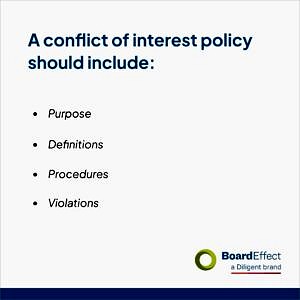
Why a conflict of interest policy is essential for charity and nonprofit boards
Avoiding conflicts of interest may feel like running through video game levels — Super Mario-style — for charity and nonprofit board members. It’s understandable. Board members are recruited because of their well-rounded experiences, professional connections and involvement in their communities. These very qualities make potential conflicts of interest almost a certainty.
So board members and their organisations must be both vigilant about and protected from the risks of conflicts of interest, which makes a strong conflict of interest policy one of the most important tools a mission-driven organisation can have.
Let’s dive into what conflicts of interest are, the risks of allowing conflicts of interest, how to draft a thorough conflict of interest policy and how technology can help manage all of these efforts.
What constitutes a charity or nonprofit conflict of interest?
To put it simply: Board directors should not benefit financially, personally or otherwise from board events or activities.
A conflict of interest concerns a board director who has a barrier that prevents them from being impartial and loyal to the organisation. Conflicts can arise from personal, professional or volunteer positions or relationships. Board members have a fiduciary responsibility to put the organisation’s interests above their own; having a conflict of interest is directly at odds with that requirement.
Additionally, an apparent conflict of interest is a situation that causes an observer or third party to question whether a board director can be objective or impartial because of a competing interest where they may have dual allegiance. An apparent conflict of interest may not in fact include wrongdoing, but the mere question or doubt it inspires can do great harm to an organisation’s reputation.
Why does a charity board need a conflict of interest policy?
A conflict of interest policy prevents directors with conflicts from participating in discussion, reporting or voting on any issue where there is a real or perceived conflict. Charities and nonprofits need a conflict of interest policy for clear legal reasons as well to ensure shared understanding among the board and other stakeholders.
The Charity Commission for England and Wales states that “Where trustees don’t identify or properly respond to a conflict of interest, there can be serious consequences for the affected trustee, the charity, and public trust and confidence in charities generally. Where trustees have acted outside the terms of the charity’s governing document or the law, their decision may not be valid. It could be challenged by the Commission or by an interested party, such as a beneficiary of the charity. Where trustee actions or failings present a serious risk to the charity, the Commission is likely to regard this as mismanagement or misconduct and take regulatory action.”
“Where trustee actions or failings present a serious risk to the charity, the Commission is likely to regard this as mismanagement or misconduct and take regulatory action.” – Charity Commission for England and Wales
Board effectiveness reflects the board’s ability to deliver on its mission and achieve its goals. Organisations must be all at once more informed, more secure, more collaborative and more purpose-driven. Our free board effectiveness checklist organised into key areas will help your nonprofit board operate even more effectively. Download it now.
__________________________________________________________________________
How to regularly address possible conflicts of interest
It’s not overly difficult for charity and nonprofit boards to address conflicts of interest, but it does take some effort. All board members must have a shared understanding of what conflict of interest is and the risks it brings. Compliant boards work toward raising awareness about potential conflicts so that all directors will recognise them when they see them. The general idea is to create a culture of candor, where board directors can express conflicts of interest candidly and confidently, without fear of judgment.
Many boards take the first step toward opening up discussions about conflicts of interest by putting it on their board meeting agendas, including it as board development. Discussions around conflicts of interest may include examples, hypotheticals and even role-playing possible scenarios board members could face. These discussions set the stage to build the board’s confidence in handling any conflicts of interest if they occur.
Another approach is to require board directors to fill out an annual questionnaire that makes clear whether board directors have any current conflicts of interest and reminds them that they need to disclose any known or perceived conflicts of interest that arise at any time during their terms of board service.
The board president or secretary should request that each director sign the conflict of interest policy when they take office and keep a copy in their file.
What should a conflict of interest policy contain?
A conflict of interest policy is a written document that typically has distinct sections for explanations. The essence of a conflict of interest policy requires anyone who has — or thinks they have — a conflict of interest to disclose the conflict. Directors with conflicts of interest must also abstain from discussing or voting on the matter.
The Charity Commission provides guidance on how to draw up your conflict of interest policy.
A conflict of interest policy should include the following sections:
- Purpose
- Definitions
- Procedures
- Violations
The policy should allow space for board directors to sign and date the policy.

Documenting conflicts of interest in meeting minutes
Documenting disclosure of a conflict of interest in the meeting minutes serves multiple purposes. Primarily, documenting conflicts and potential conflicts will help charities avoid undue penalties or other sanctions. Recording conflicts also serves to clarify that the board takes conflicts of interest seriously to any member, third parties, observers or regulators, which is also a reflection of the organisation’s reputation for having strong ethics.
The minutes should name the board director with the conflict, disclose the type of conflict and state how the board managed it. The minutes should clarify whether board discussions about the matter took place with the affected board director inside or outside of the room. Most importantly, the minutes should state whether the board took a vote on the matter and whether the director with the conflict voted or abstained.
Using your board management software to support compliance
Your organisation’s board management solution can be an invaluable aid throughout the processes of creating a conflict of interest policy and staying vigilant about compliance. BoardEffect has the following features that can help:
- A built-in surveying tool can be used for annual collections of board member conflicts of interest.
- Automated workflows simplify policy development, with easy editing, electronic approvals and quick clicks to supporting materials (such as documents defining conflicts of interest).
- The user-friendly dashboard and robust document library offer options to speed board development on topics like conflicts of interest and make it more consistent.
Understanding and avoiding conflicts of interest is a key way board members can serve their organisations and protect themselves at the same time. BoardEffect offers the integrated features to support the education and efforts the board needs to keep the organisation safe.







